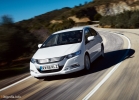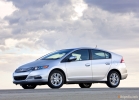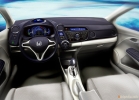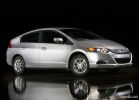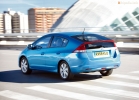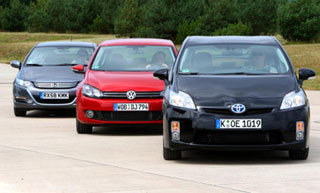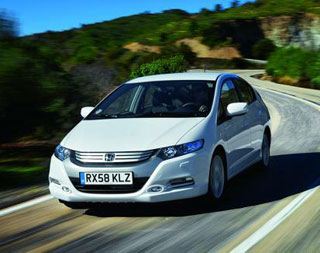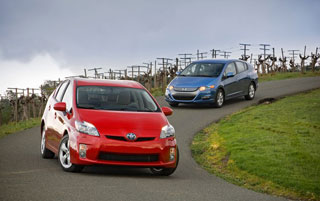Honda Insight Test drive since 2009 hatchback
The formula of the future
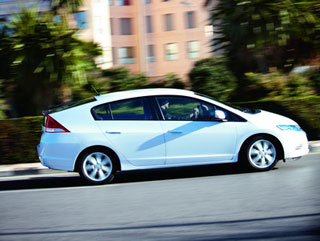 Just imagine: the car eats smaller, and rides a frozen one, and at the same time causes minimal harm to the environment. It is not without reason that 37 models with hybrid power plants are already sold in America, and in Japan even more. Very soon, it may be, to buy a car with an ordinary ICE under the hood will generally become an bad tone. However, there is but the price. As it turned out during a recent survey, 40% of potential buyers do not consider the possibility of acquiring a hybrid car for the only reason it costs more than classmates. Here, the second -generation Honda Insight acts as a destroyer of stereotypes: the Japanese company claims that it will be the most affordable hybrid in the world. True, at the time of the first official test drive in Valencia, the price list was not announced: in Europe, prices will be announced on April 18, when the car appears with dealers. He will come to Russia over the next two years when exactly has not yet been determined. Now, if the government, as in America, will begin to pay extra for economical and environmentally friendly cars, but in any case, it is worthwhile to take a closer look. I did it with pleasure and, it seems, understood why Insight could be inexpensive and in demand.
Just imagine: the car eats smaller, and rides a frozen one, and at the same time causes minimal harm to the environment. It is not without reason that 37 models with hybrid power plants are already sold in America, and in Japan even more. Very soon, it may be, to buy a car with an ordinary ICE under the hood will generally become an bad tone. However, there is but the price. As it turned out during a recent survey, 40% of potential buyers do not consider the possibility of acquiring a hybrid car for the only reason it costs more than classmates. Here, the second -generation Honda Insight acts as a destroyer of stereotypes: the Japanese company claims that it will be the most affordable hybrid in the world. True, at the time of the first official test drive in Valencia, the price list was not announced: in Europe, prices will be announced on April 18, when the car appears with dealers. He will come to Russia over the next two years when exactly has not yet been determined. Now, if the government, as in America, will begin to pay extra for economical and environmentally friendly cars, but in any case, it is worthwhile to take a closer look. I did it with pleasure and, it seems, understood why Insight could be inexpensive and in demand. Airy gymnastics
Honda itself determines the design of Insight, a phrase athlete strangely sounding in Russian. There is, however, an air gymnast that is quite understandable to the circus term. In a sense, it was precisely air gymnastics that engineers and designers were engaged in when they designed Insight they sought a minimum aerodynamic resistance coefficient. Ultimately, this desire has determined the appearance of the model.
Of course, INSIGHT started not from scratch, the car greatly resembles the concept of FCX Clarity, which Honda showed at several car dealerships. The same body shape, the cabin, as it were, is a single whole with a hood and smoothly passes into the radiator grille the optimal aerodynamic configuration. A slightly raised feed, located at a precisely designed angle, ending with a spoiler all this, we can say, was born in an aerodynamic pipe, where the model spent many hours. As a result, we have an aerodynamic resistance coefficient of 0.28. It is only better for sportsmen.
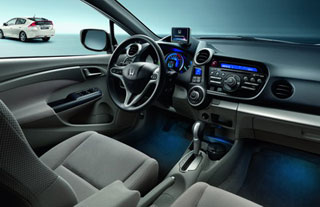 Only the benefit of InSight has a stylistic resemblance to the FCX Clarity in a rapid appearance, there are branded features, healthy aggression, and some aspiration for the future. For example, Insight is equipped with thin projection headlights in the form of a 4-diode cluster. They are supplemented with blue backlight, and the overall lights are located at the bottom of the bumper. Here is a powerful air intake and inserts from matte chromium. In a word, the front of the designers was especially successful. The feed is sustained in a more calm style, although its shape is unusual. LED lights and stop-signals with sharp faces are noteworthy. True, such a configuration significantly limits the review in the rearview mirror, but aerodynamics requires sacrifices. In any case, the new Insight looks much better than the previous one.
Only the benefit of InSight has a stylistic resemblance to the FCX Clarity in a rapid appearance, there are branded features, healthy aggression, and some aspiration for the future. For example, Insight is equipped with thin projection headlights in the form of a 4-diode cluster. They are supplemented with blue backlight, and the overall lights are located at the bottom of the bumper. Here is a powerful air intake and inserts from matte chromium. In a word, the front of the designers was especially successful. The feed is sustained in a more calm style, although its shape is unusual. LED lights and stop-signals with sharp faces are noteworthy. True, such a configuration significantly limits the review in the rearview mirror, but aerodynamics requires sacrifices. In any case, the new Insight looks much better than the previous one. Space interior
Inside, you first catch yourself on the feeling that you are really in a car of the future. On the one hand, the organization and decoration of the interior echoes other Honda models, I have already seen something similar, for example, in Civic. But if there is an avant -garde, then here is its quintessence. In front of the driver is a two -level dashboard, the upper part of which is a digital speedometer, and the lower large tachometer. On both sides of the tachometer there are indicators: on the left of the operating mode of the electric motor, on the right of the fuel level. Having glanced at the devices, the driver knows the batteries at any time, or the electric motor helps the gasoline engine. The multifunctional LCD display in the center of the tachometer is always ready to provide any information from the on-board computer and even help choose the most economical driving technique, which I will say a little below. The steering wheel is exactly like in Civic, and it only pleases me.
The front two-level panel goes around the driver and passenger, creating the feeling that you are behind the control panel of some spaceship or at least a aircraft. Numerous indicators, sensors, screens only enhance the impression. In addition, the panel is two -color. By the way, two options for the internal upholstery of dark blue are provided in combination with a cream or warm cream-beige tint. The upholstery of the seats is also two -color, with a texture pattern of fabric in peas for the seats themselves, and soft material for suede for side rollers.
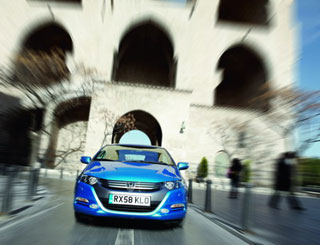 The only complaint of the plastic is hard and too smooth. It is then that you understand what the manufacturer saves on. Nevertheless, all the benefits of civilization like climate control and electric windows in the machine are. So inexpensive details somehow fade into the background by themselves. Moreover, the avant -garde style is designed.
The only complaint of the plastic is hard and too smooth. It is then that you understand what the manufacturer saves on. Nevertheless, all the benefits of civilization like climate control and electric windows in the machine are. So inexpensive details somehow fade into the background by themselves. Moreover, the avant -garde style is designed. A few words about Insight functionality. The IPU (block of high -performance batteries) has become more compact. The cargo compartment was placed under the floor of the cargo compartment, as a result, the luggage compartment has a volume of 400 liters. As on the latest Jazz and Civic models, the drowned cell under the floor of the department gives an additional 8 liters the perfect place for objects that must be taken separately, or for transporting what is desirable to cover from prying eyes. To place a larger load, you can fold the rear separated seats in a proportion of 60:40 and get a flat cargo space with a volume of 1017 liters.
There is a lot of space for any small things. There are already six cup holders in the cabin: two are built into wide and roomy door pockets, two in the rear doors, and two more are located at the gear lever. In front of the front cup holders there is a removable box with partitions, which perfectly fit the sunglasses and mobile phones. A box in an armrest between the driver and the front passenger can be equipped with a USB port, there is a pocket for an iPod inside. In addition, on each door behind the buttons of electric windows there is a niche for storing smaller objects, and another niche directly under the audio system for ligaments with keys, cards and small objects that are not recommended to keep in sight.
Filling
Although all hybrid cars have an internal combustion engine and an electric motor, today there are three main schemes of their work. The first sequential hybrid with a drive only from an electric motor. In this case, ICE is used exclusively to produce energy and charging batteries.
The second parallel hybrid. In this case, the gasoline engine plays the main role, and the electric motor serves as an auxiliary source of traction, although it is able to independently set the car in motion as necessary. It is this system that is used in Honda hybrids.
Another sequential parallel, or combined hybrid. It is used in Toyota Prius. This system has two electric motors and a gasoline engine, they can work independently of each other.
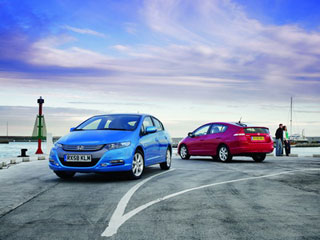 Each system has its own advantages and disadvantages. The main advantage of the parallel scheme, such as IMA from Honda, is its size and mass, they are relatively small. And they require lower costs in production, and this is the most important factor in savings and, accordingly, the availability of the model.
Each system has its own advantages and disadvantages. The main advantage of the parallel scheme, such as IMA from Honda, is its size and mass, they are relatively small. And they require lower costs in production, and this is the most important factor in savings and, accordingly, the availability of the model. In the case of IMA (Integrated Motor Assist), the IMA system consists of a 1.3 -liter gasoline engine, which acts as the main source of energy; super -compact auxiliary electric motor IMA, battery and undercurrent transmission (wedge -spray variator). Moreover, the 88-horsepower gasoline engine, created on the basis of the 1.3-liter Civic Hybrid engine, is new, equipped with an I-VTEC system that provides fuel efficiency. For example, when braking, the engine simply stalls, and when you press the accelerator pedal, it comes to life again. The electric motor, in turn, provides additional traction when accelerated. In addition, the electronics disconnects the internal combustion engine, as soon as it goes into idle mode, say, when stopping at a traffic light.
Under voltage
Frankly, I expected more from Honda Insight. Yes, acceleration is confident, but it cannot be called rapidly. With a sharp click on the accelerator, the indicator of the electric motor operates upwards, indicating that all energy is currently aimed at helping the modest gasoline motor. The tachometer hand immediately goes into the zone of maximum torque and power (for 5 thousand rpm), and the car literally breaks down. However, although the reactions to the work of the gas pedal are quite fast (the same electric motor helps), it is still impossible to call the model truly dynamic. Up to 100 km/h Insight accelerates in 12.6 seconds. In addition, acceleration is accompanied by a rather annoying rumble of a gasoline engine, it is difficult to find sports notes in it.
At the same time, you cannot complain about slowness. After all, the electric motor develops the maximum of power and torque immediately, without pauses, and therefore, with a sharp maneuver under the right foot, there is always a supply of traction. And in the city, there are no problems with dynamics at all. From the traffic light, you start briskly, even if a second earlier, the gasoline engine is strangled by electronics. By the way, a pause between pressing the accelerator, starting the motor and the beginning of movement is barely noticeable, and it, according to my sensations, is no more than a second, or even a split second. Well, if you are wasteful, then CVT, that is, the variator, offers to use the sports regime. It is enough to move the handle to position S, and on traffic lights the engine will not stall, and the reactions to the commands become sharper. True, the fast riding on Insight does not give much pleasure. Why?
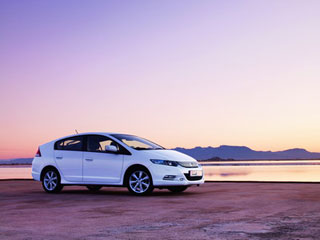 Firstly, because the steering wheel is quite light and not too informative. The effort on it seems artificial, and the reactions are slightly blurred. The reason is the mechanism of the electric power. Secondly, the pendants are rather configured for comfortable and safe driving. Let the rolls of the body on the bends are not large, when the InSight turns passage, it demonstrates a typical for cars with a drive to the front wheels insufficient rotation, as if the nose is turning back. And the stabilization system, which is standardly installed on Insight, enters into work, should be outlined to any glide. For Honda, not typical settings. Which, however, are explained by the fact that efficiency and environmental friendliness were put at the forefront. By the way, even after my trip, the average fuel consumption was only 7.2 liters per 100 km. By the way, the computer informed me that I was driving extremely not economical. How? To do this, the Honda has developed a special Eco Assist system. And on the front panel there is a special ECON button.
Firstly, because the steering wheel is quite light and not too informative. The effort on it seems artificial, and the reactions are slightly blurred. The reason is the mechanism of the electric power. Secondly, the pendants are rather configured for comfortable and safe driving. Let the rolls of the body on the bends are not large, when the InSight turns passage, it demonstrates a typical for cars with a drive to the front wheels insufficient rotation, as if the nose is turning back. And the stabilization system, which is standardly installed on Insight, enters into work, should be outlined to any glide. For Honda, not typical settings. Which, however, are explained by the fact that efficiency and environmental friendliness were put at the forefront. By the way, even after my trip, the average fuel consumption was only 7.2 liters per 100 km. By the way, the computer informed me that I was driving extremely not economical. How? To do this, the Honda has developed a special Eco Assist system. And on the front panel there is a special ECON button. He will teach to drive
Honda experts conducted a special study to find out that different drivers demonstrate not at all the same fuel economy. For example, at an average speed of 30 km/h, the difference in the actual fuel consumption reached 21%. With this circumstance, the engineers finalized the management system in order to minimize the impact of various driving styles on gasoline consumption. After repeated tests, the difference was already 12%. As a result, Eco Assist technology was developed.
After clicking on the button with the inscription ECON, Insight goes into high economy mode. It means limiting power and a decrease in torque by 4% (with the exception of a state where the gas pedal is completely squeezed out); more smooth operation of the unavailable transmission; increasing the efficiency of the recruiting system of inhibition energy; idle mode; increasing the time of operation on the electric motor when stopping a car; more active operation of the air conditioning system in recirculation mode; reducing the power of the centrifugal fan to reduce energy consumption; A complete shutdown of the air conditioner in the idle mode (except for cases of extremely high temperature in the cabin) and, finally, smoothing acceleration, optimizing the position of the throttle and engine speeds. Plus, in the Insight there is an Eco Drive Bar indicator, and a special speedometer illumination system.
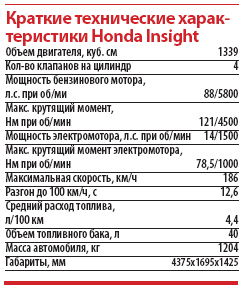 Eco Guide Bar in the display is a continuous scale indicator moving relative to the axial line. Ideally, driving should be such that the scale remains in the center and does not enter the darkened/dashed sections located on both sides. With a smooth, that is, the most economical driving, the scale is held in the center, slightly deviating to the right with gradual acceleration, and to the left during smooth braking. In such conditions, the backlight behind the speedometer begins to glow green light, which indicates the optimal control mode. With more intense acceleration or during moderate braking, the scale deviates more strongly to the sides, which reflects a higher fuel consumption, and the backlight becomes blue. Well, if you go quickly, the scale deviates to the right or left to the limit, entering the darkened areas, and the backlight burns blue. To stimulate the driver, there is another display over the scale indicator.
Eco Guide Bar in the display is a continuous scale indicator moving relative to the axial line. Ideally, driving should be such that the scale remains in the center and does not enter the darkened/dashed sections located on both sides. With a smooth, that is, the most economical driving, the scale is held in the center, slightly deviating to the right with gradual acceleration, and to the left during smooth braking. In such conditions, the backlight behind the speedometer begins to glow green light, which indicates the optimal control mode. With more intense acceleration or during moderate braking, the scale deviates more strongly to the sides, which reflects a higher fuel consumption, and the backlight becomes blue. Well, if you go quickly, the scale deviates to the right or left to the limit, entering the darkened areas, and the backlight burns blue. To stimulate the driver, there is another display over the scale indicator. With the optimal control mode, small leaves light up over the scale, reflecting the success of the driver in the development of an environmentally friendly driving style. The more leaves, the better, the flower is very good. At the end of the trip, when the ignition turns off, on the black and white display, instead of the Eco Guide indicator, the Eco Score screen appears. Now the leaves of the leaves are on top of the report on the work indicators during the last trip, and the scale and indicators at the bottom of the screen reflect the assessment for the entire service life. The highest tree and flower grown on the display to the right of the scale. If the driver managed to increase his own level from the moment of the last trip, a wreath is displayed in the recognition of the achievement (well, the wreath may be award). At the end of the third level, the trophy icon appears, indicating good performance. And, on the contrary, with a deterioration in the driving style, an assessment is reduced for the entire service life and return to previous levels, then the worthy plant icon appears. Funny, instructive and useful.
Hybrids to the masses!
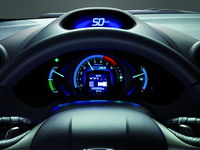 However, due to which Insight has already become a couple of thousand dollars cheaper than its main competitor to Toyota Prius in the United States, and will it be more accessible in the European market?
However, due to which Insight has already become a couple of thousand dollars cheaper than its main competitor to Toyota Prius in the United States, and will it be more accessible in the European market? The use of a large number of components of their own production makes it possible to constantly improve technological processes, which would be impossible when working with third -party suppliers, said the head of the InSight Sekoi project. Therefore, at the factory in the city of Suzuka, a line of assembly of IMA electric motors was launched. In addition, many components are identical to the new Honda Jazz.
Hence the rather optimistic plans. Honda intends to sell 200,000 Insight per year, of which half in the United States. The leadership of the concern believes that by the middle of the next decade, the share of hybrids will reach 10% in the total sales of Honda brand cars. Therefore, new such models are being prepared. In particular, a sports hybrid (based on the CR-Z concept), as well as a hybrid version of Jazz, in addition to the already serial Civic Hybrid. Due to the release of these four models, Honda hopes to sell more than 500,000 hybrids per year.
Andrey Osipov
Valencia Moscow
Photo Honda
Honda Insight Test Drive Video since 2009
Honda Insight Crash Test Video since 2009
Honda Insight Test drives since 2009
Honda Insight Crash Test since 2009
Krassh Test: Detailed Information90%
Driver and passengers
76%
Pedestrians
74%
Children-passengers
86%
Active security system

